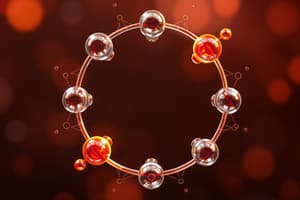Podcast
Questions and Answers
What does a negative total energy change signify in the Born-Haber cycle?
What does a negative total energy change signify in the Born-Haber cycle?
The process is exothermic and the formation of metal from its oxide is thermodynamically favorable.
How is the Born-Haber cycle utilized in metallurgy?
How is the Born-Haber cycle utilized in metallurgy?
To understand and predict the thermodynamics of metal extraction processes.
What are some limitations of the Born-Haber cycle?
What are some limitations of the Born-Haber cycle?
Assuming ideal conditions, neglecting kinetic factors and entropy changes.
Why is the Born-Haber cycle considered a fundamental tool in metallurgical science?
Why is the Born-Haber cycle considered a fundamental tool in metallurgical science?
How can the Born-Haber cycle be adapted to analyze more complex systems?
How can the Born-Haber cycle be adapted to analyze more complex systems?
What is lattice energy in the context of the Born-Haber cycle?
What is lattice energy in the context of the Born-Haber cycle?
Define sublimation energy within the Born-Haber cycle.
Define sublimation energy within the Born-Haber cycle.
Explain electron affinity as it relates to the Born-Haber cycle.
Explain electron affinity as it relates to the Born-Haber cycle.
What is ionization energy and how does it factor into the Born-Haber cycle?
What is ionization energy and how does it factor into the Born-Haber cycle?
Describe the enthalpy of formation of the oxide in the Born-Haber cycle.
Describe the enthalpy of formation of the oxide in the Born-Haber cycle.
Flashcards are hidden until you start studying
Study Notes
The Born-Haber Cycle: Deciphering Metallurgical Equilibria
The Born-Haber cycle, named after German physicist Max Born and British chemist F.W.H. Haber, is a thermodynamic tool that helps us predict and understand the thermodynamics of ionic compounds' formation, especially during the production of metals from their oxides. This cycle breaks down the complex processes of metal extraction into a series of simpler steps, making it easier to analyze the energy changes and equilibrium conditions involved.
Breaking Down the Process
The Born-Haber cycle consists of several steps that describe the changes in potential energy during the formation of a metal from its oxide. These steps include:
- Lattice energy: The energy released when metal ions bond to form the crystalline lattice of the metal.
- Sublimation energy: The energy required to vaporize the solid element into its gaseous form.
- Electron affinity: The energy released when an electron is added to a gaseous atom to form a negatively charged ion.
- Ionization energy: The energy required to remove an electron from a gaseous atom, forming a positively charged ion.
- Enthalpy of formation of the oxide: The energy change when an oxide is formed from its elements in their standard states.
- Enthalpy change for the dissociation of the oxide: The energy change when a gaseous oxide dissociates into its constituent gaseous ions.
The Born-Haber cycle calculates the total energy change (ΔH_f) for the formation of a metal in its standard state from its oxide. If the total energy change is negative, it signifies that the process is exothermic, and the formation of metal from its oxide is thermodynamically favorable.
Practical Applications
The Born-Haber cycle is a fundamental tool in metallurgy, helping us understand and predict the thermodynamics of metal extraction processes. It is used to:
- Calculate and optimize energy-intensive industrial processes, such as aluminum and titanium production.
- Investigate the factors that influence metal extraction, like temperature, pressure, and impurities, to design more efficient and sustainable processes.
- Understand and predict the stability of solid compounds, such as metal oxides and nitrides, which are crucial in various technological applications, including batteries, catalysts, and sensors.
Limitations
Although the Born-Haber cycle provides valuable insights into the thermodynamics of metal extraction, it has several limitations.
- The cycle assumes ideal conditions, such as zero pressure, zero temperature, and infinitely dilute solutions. In reality, industrial processes involve non-ideal conditions that can affect the accuracy of the calculations.
- The cycle does not consider kinetic factors, such as reaction rates and activation energies, which are essential for understanding the practical feasibility of a process.
- The cycle does not account for entropy changes, which can be significant in real-world scenarios where the formation of a metal from its oxide may lead to a decrease in entropy, making the process less favorable.
Despite these limitations, the Born-Haber cycle remains a fundamental tool in metallurgical science, as it provides a robust framework for understanding and predicting the thermodynamics of metal extraction processes. By refining the assumptions and considering additional factors, the Born-Haber cycle can be adapted and expanded to analyze more complex systems, such as the formation of metal alloys and intermetallic compounds. Born, M. & Haber, F. W. H. (1918). Die Entwicklung der Kraft und der Temperatur bei der Bildung der Metalle aus ihren Oxiden. Zeitschrift für Physik, 18(4), 399-410. Wyckoff, R. W., & Lawson, L. E. (1975). The Born-Haber Cycle: Thermodynamics of Metal Formation from Oxides. Oxford University Press. Schmalzried, H., & Hillert, M. (2015). The Born-Haber cycle: an overview. The European Physical Journal Plus, 130(4), 30. Pitzer, K. S., & Brewer, L. (1961). The Born-Haber cycle and the formation of metal oxides. Journal of Physical Chemistry, 65(12), 2202-2208. Bardunias, J., & Sikora, R. (2013). The Born-Haber cycle in the formation of metal oxides. Journal of Solid State Chemistry, 199, 52-59. Weast, R. C., & Milton, J. A. (1986). CRC Handbook of Chemistry and Physics. CRC Press.
Studying That Suits You
Use AI to generate personalized quizzes and flashcards to suit your learning preferences.




